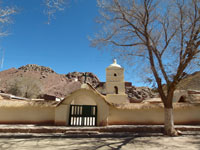 |
 |
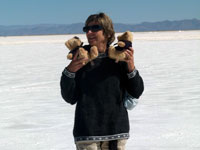 |
 |
 |
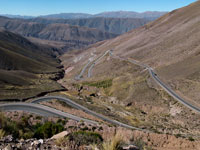 |
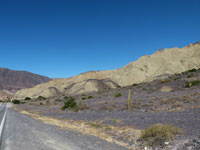 |
 |
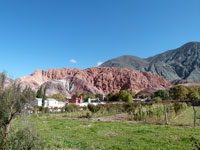 |
From San Pedro de Atacama to the Argentine border was only a couple of hours run. The excellent road goes steadily, but not steeply, up to the Jama International pass. There were few other travelers crossing art midday, and we circuited the 4 bureaucratic stations (passports out and vehicle out of Argentina, and passport in and vehicle in to Chile) in remarkably quick time. There was a one hour time difference, but like Phileas Fogg, I did not realise it till some time later.
We dropped down the Argentinean side of the Andes to Susques, where we had been a few years previously and had been charmed by the church and enjoyed a nearby cafe. Unfortunately this time both the cafe and the church were closed. So we just found an ATM, got some money, and motored on.
Click on any of the thumbnails below to get a larger photo
 |
 |
 |
 |
 |
 |
 |
 |
 |
From Susques, the road runs across the Grand Salar, where the Boys were almost tempted to a swim, and we had the bizarre sight of a lorry loading a dozen horses, and surrounded by gauchos in full gear (we never did find out what they were doing there) . After that the road drops steeply down past the coloured hill at Punamarca. We made the mistake of following the RN9 all the way to Salta (there is a longer, but quicker, alternative).
Here we were stopped at one of the many local police blocks that pervade Argentina. This was the only cop on the make we encountered. I was pulled up for not having dipped headlights on - I was using sidelights, the law is not clear in Argentina as to what you need to use. A long argument in Spanish ensued, and at one stage I pointed out a lorry with no lights passing his checkpoint, unmolested by the police. His reply was that he could see their lights! In the end we departed, having been reported for a traffic violation, but no money changed hands.
By the time we got to Salta it was starting to get dark. Salta is a big place, and the maps I had printed out were not up to the task of getting us to the hotel. Eventually we found it. It was discreet to the point of being invisible. Without knowing the street number, one could not have found it. The car had to go into a nearby garage, which was interesting, as the parking slots were designed for normal cars, not hulking great pick up trucks. Anyway, with some difficulty, this got parked and two days later un parked.
 |
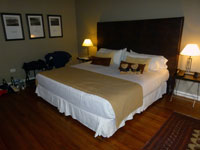 |
 |
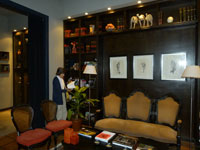 |
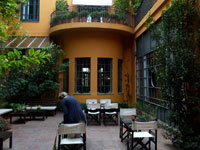 |
Legado Mitico was our hotel. We stayed in this hotel for two nights. A wonderful old world feel to the place. Fantastic public rooms, and an excellent colonial bedroom (lighting could be better, but that is a minor quibble). In reality this is actually a " bed and breakfast" rather than a "hotel". You cannot get either lunch or dinner here. There is a bar open from 18.00 to 21.00 but they cannot serve a Pisco Sour, only wine, beer or G & Ts
Breakfast was not bad, but not good either. My main problem was with the waiter. He removed our plates, cups and place mats, even though there were 10 minutes before the end of breakfast. He was brusque to the point of rudeness. Same bloke both mornings.
The receptionist on arrival was slightly less than welcoming. But the porter who guided me to the parking garage was charming.
The position of the hotel is not ideal, at five blocks from the main square, along roads that have little charm.
But overall I would recommend this hotel, if you are happy with the negatives. If I went to Salta again, I would probably look for an alternative, and end up staying here again!
 |
 |
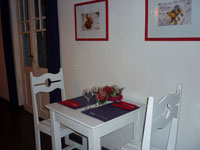 |
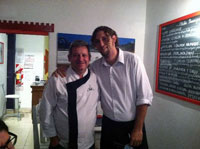 |
Ma Cuisine is where we dined both nights. We took a long walk from our hotel in order to eat here. It was so good we took the same long walk the next night.
In common with most restaurants in Salta, they open late at 20.00. The streets of Salta are perfectly safe for walking at night, though you could always take a taxi.
The menu is on a blackboard on the wall. It is a limited choice, but the cooking is excellent. You do not need a wider choice. Over the two nights we ate here, we covered much of the menu.
I particularly enjoyed the Lomo and the Broccoli and Potato mousse. Among the puddings, the Creme Brûlée was particularly good
The waiter will guide you on the small wine list. Particularly noteworthy are the selection of half bottles.
The service from both the waiter and the chef was friendly and enjoyable.
We would recommend the restaurant and would eat here ourselves if we were back in Salta
 |
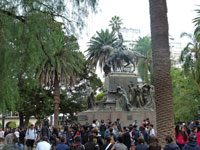 |
 |
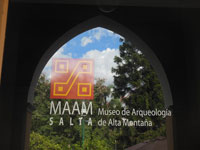 |
 |
 |
 |
 |
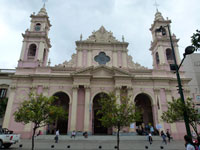 |
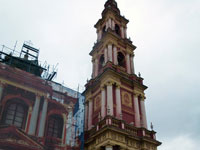 |
 |
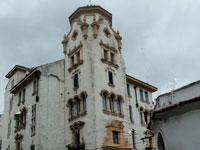 |
The day we had in Salta was spent re-visiting some of the sights that we had seen before, and also taking another look at the mummies in the MAAM (Museo de Arqueologia de Alta Montana)
MAAM has a serious and informative exhibition focusing on Inca culture and, in particular, the child sacrifices the Inca left on some of the Andes’ highest peaks (they were found at 6700 m ). According to contemporary writings by Spanish priests, these children were participants in capacocha, a sacrificial rite that occurred in celebration of key events in the life of the Inca emperor.
The centrepiece of the display is the mummified body of one of the three children (rotated every six months) discovered at the peak of Llullaillaco during the 1999 expedition. It was a controversial decision to display the bodies. The intricately plaited hair and clothes are perfectly preserved. Three days into their search for Inca sacrifice sites in 1999, Reinhard's team discovered the grave site containing two girls and one boy. Several gold, shell and silver statues, textiles and pottery were also found. The younger girl's body had been struck by lightning, causing burn damage across her body. The other two mummies remained in good condition. Statues made of precious metals and textiles were among the grave goods found
The oldest mummy, a girl found to be around the age of fifteen, was dubbed "La Doncella" which translates to "The Maiden". A bacterial infection was discovered in her lungs during an examination. She wore a dress with her hair braided, along with a headdress. DNA testing indicated that the two girls were half sisters, where the boy was no relation. La Doncella had been drugged by coca leaves and a maize beer known as chicha, dying in her sleep, which was also present in the other mummies. It is believed that La Doncella was an aclla, or Sun Virgin. That is, she was chosen and sanctified as a toddler to live with other girls and women who would become royal wives, priestesses, and sacrifices.
The practice of ritual sacrifice in the Inca society was to ensure health, rich harvests and preferable weather. "La niña del rayo", or "Lightning Girl" was approximately six years old when she was sacrificed. Her face and part of her shoulder were damaged by a lightning strike that occurred after her death. The body of the boy had been tightly wrapped, as some of his ribs and pelvis were dislocated. He apparently died under stress, as vomit and diarrhoea was found on his clothing. He was the only child who was tied up.
The grave goods that accompanied the children impress by their immediacy, with colours as fresh as the day they were produced. The illas (small votive figurines of animals and humans) are of silver, gold, shell and onyx, and many are clothed in textiles.
Also exhibited is the ‘Reina del Cerro,’ a mummy robbed from an Inca tomb in the 1920s that finally ended up here after a turbulent history.
From Salta we headed off south to Tafi del Valle